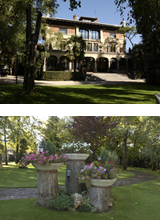
|
| Rear façade and gardens |
The Palace brings together all the heavy construction on its rectangular floor plan and an acute sense of architectural horizontality with its prismatic elevation, typical of the regionalist constructions of the first quarter of the 20th century. Removed from the reigning academicism at a time when new currents in architecture were in full effervescence in Europe, the Palace of Ajuria Enea did not renounce the palatial elements of the 16th century or the medieval pieces that were common in the house-towers of the 15th.
It is necessary only to pause in order to contemplate the harmony it enjoys with its environment, an urban enclave in the centre of Vitoria-Gasteiz, replete with aristocratic houses and gardens of great beauty for the visitor.
But the history of the Palace of Ajuria Enea, like that of the area in which it stands, is replete with charm. Having become the residence of the Ajuria family, it was handed over in 1966 to the religious order of the Madres Escolapias, who converted it into one of their schools. Six years later, in 1972, it was purchased by the Provincial Council of Alava for conversion into a museum of Basque art.
|

